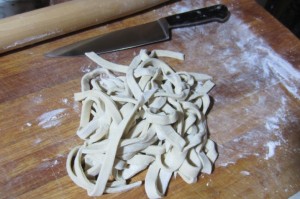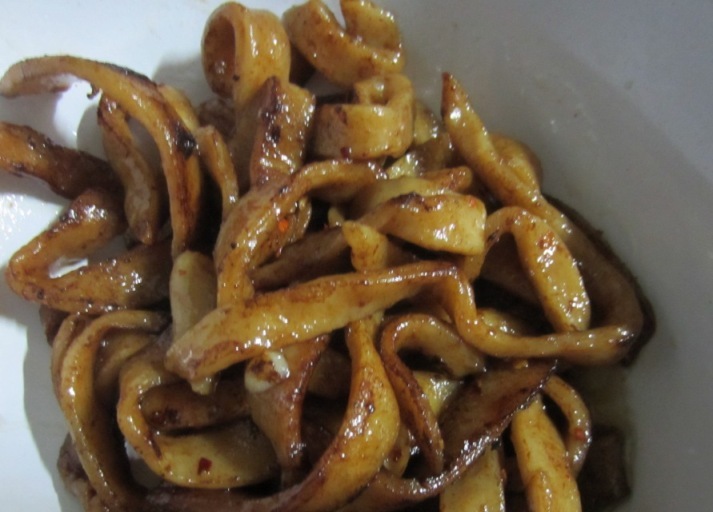Asian noodles come in all manners of size and composition. Whether rice or wheat, flat or round, egg or not, the permutations are endless. The blight that is pre-fried ramen* in over-salted polystyrene cups couldn’t be farther from the art of handmade noodles.
*For the record, authentic fresh, real ramen is pretty darn good noodling.
I had a favourite Chinese takeaway spot years ago that has long since changed owners and menus turning one of my all time favourite foods into a treasure hunt. They made a dead simple dish – actually just a three-dollar side starch listed next to plain rice and extra fortune cookies – so often found on my order that the staff soon got in the habit of starting our conversations with “What do you want with your noodles today?” While they made very respectable shitaki pot stickers and their ma pao do fu (stir fried tofu) was out of this world, it was the thick-cut satisfyingly toothy spinach noodles that made me linger for a takeaway when I dropped off their weekly order from my own shop. To be honest, I ate there enough that all we did was barter and I’m sure they got the short end of the deal.
Made on premises daily by hand, occasionally with me watching in wonderment, they did little more than pan fry the pre-boiled noodles to heat through with toasted sesame oil and the smallest measure of chile sauce. A dusting of sesame seeds finished them off before being generously scooped into waiting waxed paper boxes. Hot or cold you couldn’t ask for a more satisfying portable feast and many was the time that they turned my evening drive into an impromptu picnic stop near the waterfront boardwalk or canal park. “Yes dear, I’m going to be a bit late getting home. No, I’m not working. I stopped for noodles. Yes, I got you some too.”
It took me quite a while to get over leaving that little noodle gem and even longer to finally recreate them to my satisfaction. The secret to great noodle mouth feel (and pillow-soft steamed buns for that matter) is alkaline water, jian shui 梘水 in China or kansui in Japan, which is made with potassium carbonate in milder kitchen alchemy or the more dangerous sodium hydroxide (aka lye) on the serious end of the pH manipulation spectrum. It is a common ingredient sold as a powder or solution in Asia where the handling and dangers are understood but in the west, fear and lawyers conspire to keep if off the shelves of most home noodle makers.
Thankfully there’s a bit of kitchen science that can rescue your noodle efforts. Common baking soda is sodium bi-carbonate and not strong enough to have an effect on your dough but if you bake it in a low oven (120C, 250F) for an hour, you transform it into sodium carbonate which does have enough power to make your noodles silky and your steamed buns springy. Store it in an airtight container and make alkaline water by adding two teaspoons per 250 ml (~ 1 cup), stirred well to dissolve. There will be a mildly sulphurous, ‘boiled egg’ aroma when you make the alkaline water and when you make your noodle dough. This is perfectly normal and won’t be noticeable in your finished dish.
The thick, flat style of noodles I was after generally come from Shanghai and farther north in China. I found myself south of there in Jinhua at the peak of my quest but decided to interrogate the local noodle Jedi for tips anyway hoping to piece together the bigger starchy puzzle. I even carried a photo of my beloved takeaway from home to illustrate what I was trying to achieve, a picture being worth many more than a thousand of my strained Mandarin words, and my guides instantly recognized the sort and were incredibly helpful in the quest. If you want to open multicultural doors in deepest China, just start talking about noodles or a love of food in general. The Great Social Wall of China itself melts in the heat of the cooking fires, language barriers are replaced by ingredient waving or technique gestures, and you instantly make a hundred new friends when you cook and eat together in a Chinese kitchen.
Start with “plain” noodles just to get your hand in but then begin tossing around other flavours (and colours) to see what you like. A handful of noodles is hardly much risk. After many attempts I think I’ve finally nailed down the spinach noodles of my memory but over the course of hundreds of trials I also fiddled around with some playful additions in the process. Black eggplant, orange sweet potato, and multicoloured bell peppers to name a few. Completely unauthentic some of them are but just as good on the plate. There was one thing that became clear. It’s really hard to make a bad noodle. They might not be exactly what you’re after when you start a batch but even the failures are pretty darn tasty. Give your noodle trials a go and see what you come up with. Report back here with wild success stories and miserable failures.

Thick Cut Chinese Style Noodles of Many Colours
Pick one of the following:
60 grams (~ 2 ounces) fresh spinach leaves, cleaned (for green)
80 grams (about 1/2 large) sweet bell pepper, skin and seeds removed (for red or yellow)
50 grams additional flour + 25 ml additional alkaline water (for plain)
Then proceed with:
125 ml alkaline water (see text above)
1 large egg yolk
250 grams all-purpose flour
1 teaspoon sea salt
extra flour needed for dusting
Yield: roughly 400 grams (14 ounces) noodles, enough for two generous servings
Using a blender on high power, make a very smooth slurry of the spinach or pepper and alkaline water. Add the egg and pulse briefly just to combine.
In a large mixing bowl, blend the flour and salt then add the blender mixture. Stir with chopsticks or similar to combine and switch to using floured hands until the dough becomes a cohesive ball. Turn out onto a floured work surface and knead until smooth, at least six minutes. Wrap in plastic wrap and rest for thirty minutes.
No, really. It has to rest or you’ll never get the noodles rolled out properly. Don’t rush your dough. No cheating.
Roll out the dough to an even 1/8″ thickness roughly 15 inches square but don’t worry much about the shape. Thickness is the more important dimension here. For consistency, some use square chopsticks of the desired thickness as guides for your rolling pin or if you wish you can employ a pasta roller set to fairly thick output. Dust the surface with flour well and fold into thirds along one side to make even cutting easier across the shortened dimension. Cut the noodles with a large blade into thick ribbons between 1/4″ and 1/2″. Dust again with flour and shake the pile of cut noodles to separate.
Bring four quarts or more of water to the boil and salt generously. Boil the noodles in uncrowded batches as needed until tender, about eight minutes. For use in further stir-fry dishes, rinse the cooked noodles in cold water and drain well before adding to a recipe.
Sesame Fried Dragon Noodles
Two cups of freshly boiled and drained hand-cut noodles (above), any colour or combination
1 tablespoon vegetable oil
1 teaspoon chile-garlic sauce (or use your favourite brand of ready-made)
1 tablespoon sesame oil
1 tablespoon toasted sesame seeds
Preheat a wok or heavy skillet over highest heat. All at once add the noodles, oil, and chlie-garlic sauce. Fry the noodles by moving them through the vegetable oil and chile/garlic quickly just until heated through. Add the sesame oil and toss to coat over heat briefly, about thirty seconds, then immediately remove from the pan to prevent scorching. Sprinkle with sesame seeds and serve hot or chill completely for a cold picnic treat.

